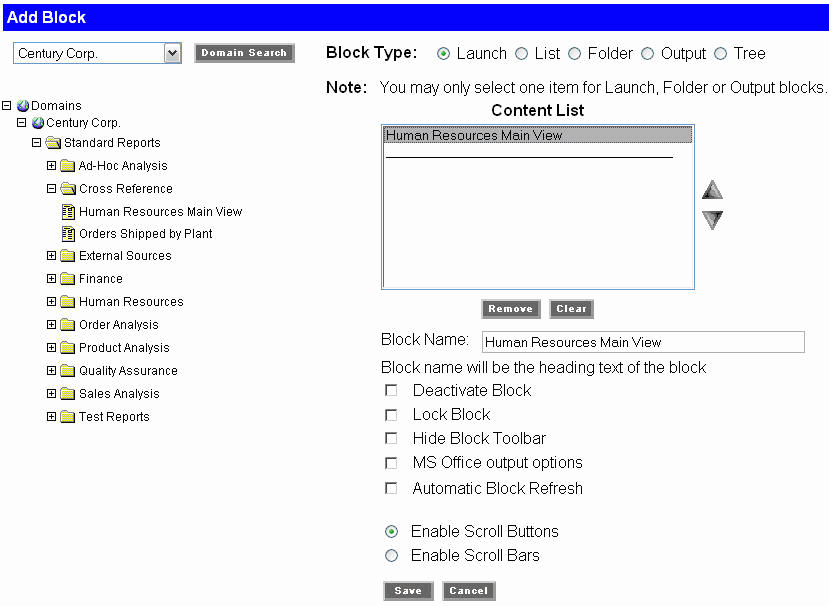
WebFOCUS Online Help > Managed Reporting Administrator > Creating Dashboard Content > Adding a Content Block
In this section:
How to: |
From the Add Block window, you can create content blocks that the public or group users see when opening Dashboard.
The following are the types of content blocks you can create:
A launch block that is created to display a report in EXL2K, EXCEL, or DOC formats should use scroll bars instead of scroll buttons.
By default, all subfolders in a folder block are expanded and cannot be collapsed. Optionally, all subfolders can be displayed as a collapsible tree and expanded as needed. This functionality can be set globally for all views by editing a variable setting in the bid-config.xml file or set for specific views using the Dashboard View Builder. For details, see How to Display a Collapsible Tree in the Folder Blocks of All Views or How to Display a Collapsible Tree in the Folder Blocks of Specific Views.
When you create an output block, scrolling options are not available. Scroll bars appear when necessary.
Note: Some Web sites bring their page to the top of a frameset when launched and take over the browser session. When these sites are opened in a launch or output block, Dashboard content is lost. It is recommended that these types of Web sites not be selected for a launch or output block.
When you add items to a content block, you can use the Domain Search from the Add Block and Edit Block windows. For details, see How to Add Items to a Content Block Using Domain Search.
Across the top of the Add Block window is a drop-down menu for selecting a domain, a Domain Search button, and option buttons to select from Launch, List, Folder, Output, or Tree for the Block Type. At the left side of the window is a tree view of the selected domain. The right side of the window contains the Content List showing selected items with up and down arrows to the right, and Remove and Clear buttons at the bottom.
Below the Content List is a text box for entering the Block Name and a series of check boxes that are available to enable the following functionality:
There are also option buttons to enable Scroll Buttons or Scroll Bars, and Save and Cancel buttons. The following image shows the Add Block window.
Note: If you are creating an Output block, adding domain items is optional since Output blocks do not require default output.
Note: Only one report in EXL2K PIVOT format can be active at a time. Therefore, it is not recommended to place output of this format type into a content block. Subsequent attempts to execute a report in this format will fail, since the original report will still be active.
If you are creating a List block you can position the items using the arrows next to the Content List.
Note:
C:\ibi\WebFOCUS76\worp\conf\bid-config.xml
<internal-var name="showFolderBlockAsCollapsibleTree" value="false"/>
to
<internal-var name="showFolderBlockAsCollapsibleTree" value="true"/>
Note: After making changes to the bid-config.xml file, use the WebFOCUS Console to clear memory cache, or restart the application. Until this is done, the change is not effective.
For more information about using the Edit Settings functionality in the Dashboard View Builder, see Customizing Dashboard Pages for a Public or Group View.
You can create a content block for a Public View that cannot be edited or deleted by a user after they create their personal view from the Public View.
In a user's personal view, the Edit option is not available for locked content blocks. In addition, the option to delete or edit locked blocks from the Content window is not available. A Dashboard user cannot remove a page containing a locked block.
The locked block is designated with a lock icon in the View Builder, Personalize content, and Manage Users sections of Dashboard. Users receive an error message if they attempt to remove a content page that contains a locked block.
The Lock Block check box is also available in the Manage Users area of the View Builder.
Dashboard administrators and authenticated users can place Report Library content in a content block using the View Builder or Personalize option. You can add Report Library content to a launch, list, output, or watch list block. The latest available version of the report always appears in the content block.
A tree of Library reports is available for selection when creating content blocks. The tree consists of the top level domain or category. Below the domain or category is the report. In the case of a bursted report, an intermediate level also appears.
The Report Library has two sets of reports. Dashboard can access both, the domain for Managed Reporting users and the category for non-Managed Reporting users.
Note:
From the Content window, you can remove a content block. Note that you can remove more than one content block at a time.
| WebFOCUS |